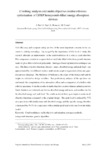Crushing analysis and multi-objective crashworthiness optimization of GFRP honeycomb-filled energy absorption devices

Use este enlace para citar
http://hdl.handle.net/2183/21645Coleccións
- Investigación (ETSECCP) [826]
Metadatos
Mostrar o rexistro completo do ítemTítulo
Crushing analysis and multi-objective crashworthiness optimization of GFRP honeycomb-filled energy absorption devicesData
2014Cita bibliográfica
Paz, J., Díaz, J., Romera, L., & Costas, M. (2014). Crushing analysis and multi-objective crashworthiness optimization of GFRP honeycomb-filled energy absorption devices. Finite Elements in Analysis and Design, 91, 30–39.
Resumo
[Abstract:] Fuel efficiency and occupant safety are two of the most important concerns in the automotive industry nowadays. Encouraged by the importance of this field of study, this research attempts an improvement in the crashworthiness of a vehicle crash absorber. This component consists in a square hollow steel tube filled with a honeycomb structure made of glass-fiber reinforced polyamide. Surrogate-based optimization techniques are used. The three objective functions chosen — mass, absorbed energy and peak load — are approximated by two different models: multivariate adaptive regression splines and Gaussian process (kriging). The thickness of both parts, the shape of the honeycomb and its height are selected as design variables. Two preliminary analyses of the specimen are performed: the computation of the interaction effect and a comparison of a hollow tube with the specimen. From the results of multi-objective crashworthiness optimization two Pareto frontiers are obtained, one for the absorbed energy and mass, and another one for the absorbed energy and peak load. The results achieved show great improvements on all objective functions compared to the original design. The peak load is reduced by 37% on a specimen with similar mass and absorbed energy, and the specific energy absorbed is increased by 39.5% for a specimen with a similar peak load to the one from the initial model.
Palabras chave
Crashworthiness
Multi-objective optimization
Surrogate methods
Honeycomb structure
Genetic algorithms
Multi-objective optimization
Surrogate methods
Honeycomb structure
Genetic algorithms





